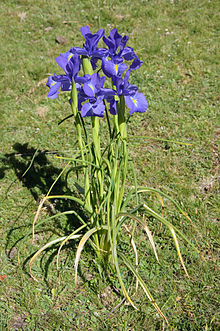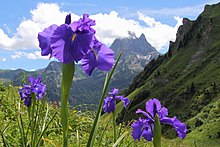Iris latifolia
| English iris | |
|---|---|

| |
| Iris latifolia, general view | |
| Scientific classification | |
| Kingdom: | Plantae |
| Clade: | Tracheophytes |
| Clade: | Angiosperms |
| Clade: | Monocots |
| Order: | Asparagales |
| Family: | Iridaceae |
| Genus: | Iris |
| Subgenus: | Iris subg. Xiphium |
| Section: | Iris sect. Xiphium |
| Species: | I. latifolia
|
| Binomial name | |
| Iris latifolia | |
| Synonyms[1] | |
| |


Iris latifolia, the English iris,[2] also known as I. xiphiodes and I. anglica, is a hardy flowering bulbous species of the Iris genus, in the family Iridaceae. It is native to the Pyrenees of Southwestern France and Northwestern Spain. It is widely cultivated in temperate regions for its purple flowers which appear in early Summer.
Iris latifolia grows to a height of 50 cm.[3] The plant produces two or three deep purple flowers with yellow marks in the center of the lower petals. Flowers have six tepals and are 12–13 cm in diameter. Leaves are stiff and sword-shaped, approximately 60 cm long, and dark green to teal in color. Leaves begin growth in early spring, before the snow has entirely melted. It is a bulbous iris, as opposed to a rhizomatous iris. The bulb has a thin, dark brown skin and grows 10–15 cm deep in the ground.[4]
References
[edit]- ^ "Iris latifolia (Mill.) Voss is an accepted name". theplantlist.org. 23 March 2012. Retrieved 12 November 2014.
- ^ BSBI List 2007 (xls). Botanical Society of Britain and Ireland. Archived from the original (xls) on 2015-06-26. Retrieved 2014-10-17.
- ^ Iris latifolia
- ^ "Iris latifolia". Royal Horticultural Society. Retrieved 23 July 2013.
